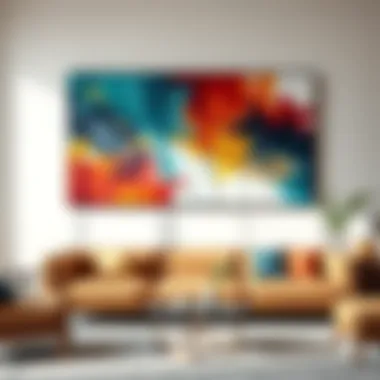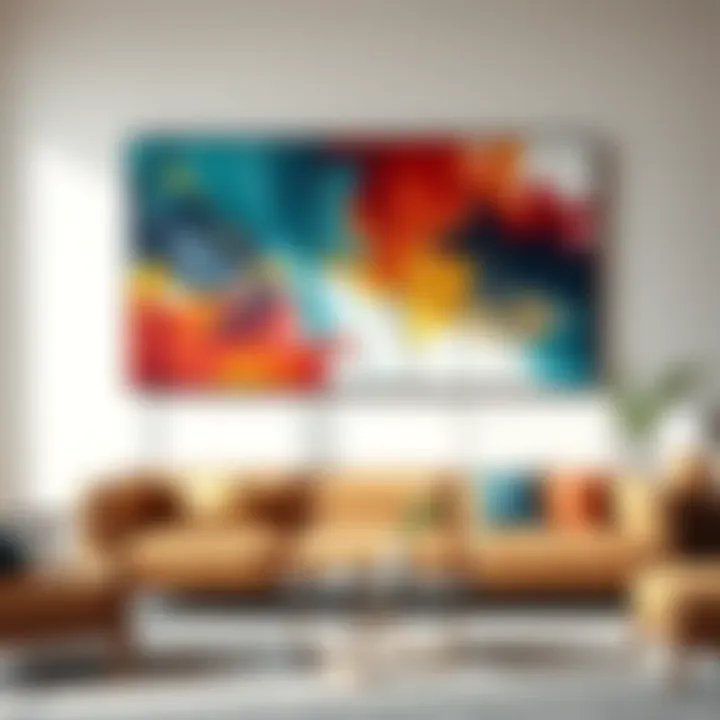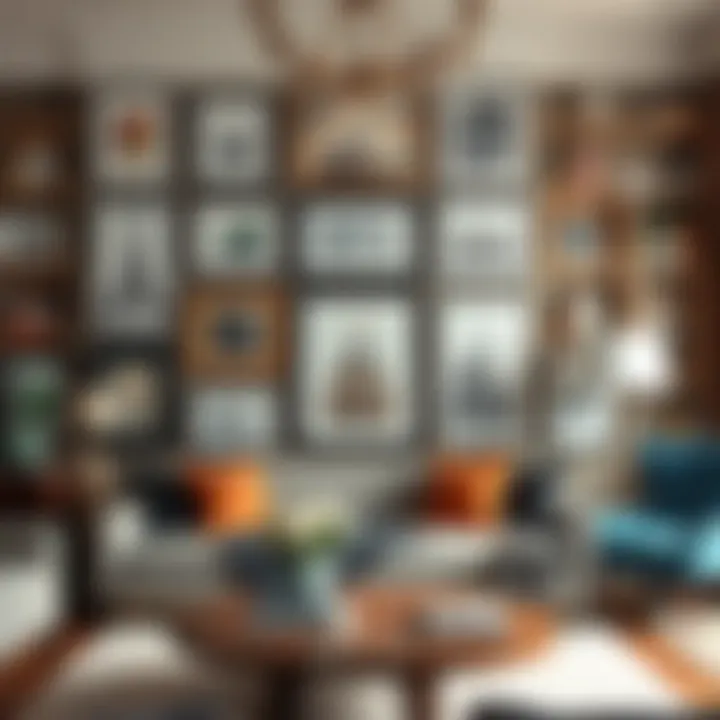Selecting Beautiful Art for Your Living Room


Intro
Art possesses a transformative power that can elevate any space, particularly a living room, which stands as the heartbeat of a home. It's not just about adorning walls; it's about expressing identity, creating mood, and fostering connections. The selection of art should resonate with the individual, reflecting personal stories and emotions, while also harmonizing with the surrounding decor.
The core challenge lies in selecting pieces that complement the myriad design elements present in a living room. This guide seeks to equip homeowners, designers, and art enthusiasts with insights into navigating the intricate world of art selection. By understanding the relationship between art and furniture design, alongside exploring current trends and practical tips, one can curate a collection that not only captures attention but also fosters a welcoming atmosphere.
Furniture Design Trends
In the ever-evolving landscape of interior design, furniture choices greatly influence how artwork is perceived. Being in tune with the latest trends helps in making informed decisions that enhance both the aesthetic appeal and functionality of a living space.
Trending Materials and Textures
Today’s design trends lean heavily on tactile experiences. The rise of raw materials and a focus on sustainability have inspired many to incorporate items made from wood, metal, and glass. For instance, reclaimed wood furniture brings warmth and an organic edge that can beautifully contrast against modern art pieces. Furthermore, the texture of fabrics, like linen and velvet, can complement artwork's nuanced color schemes, echoing their palettes.
Color Palettes and Styles
Color is not just a visual component; it's tied to emotions and perceptions. When selecting furniture, think about how the shades interact with your chosen art. Crisp whites and soft beiges serve as neutral backdrops that allow vibrant artworks to shine, whereas dark furnishings can provide a dramatic frame for lighter pieces.
Current color trends lean towards earthy tones and muted palettes with splashes of bold color—perfect for artworks that possess a vital energy. For example, a muted green couch can imbue the space with calm while providing the perfect canvas for bright abstract art. Incorporating colors found in your art throughout the furnishings can create a cohesive look.
"Art is the most beautiful of all lies—a true reflection of life and personality within a space."
Practical Tips for Furniture Selection
Choosing furniture thoughtfully also plays a critical role in showcasing your art. The balance between furniture and art should enhance the room's overall harmony and functionality while providing needed comfort.
Assessing Space and Functionality
Before diving into selections, assess the space available. Measure your living room, considering not just the floor area but also the wall space dedicated to artwork. Oversized furniture can overwhelm a small area, making art feel lost. Instead, opt for modular pieces that can easily adapt to different layouts. This flexibility allows for dynamic arrangements where both art and furniture can shine.
Balancing Aesthetics with Comfort
Art is visually stimulating, but your living room must also serve its practical purpose. Look for furniture that carries both style and comfort. For instance, a plush sofa adorned with throw pillows mirroring colors from your wall art can make for a visually inviting setup. Remember, it’s not just about how things look but how they feel when you step into the space.
By carefully considering how each piece interacts with your chosen art, you create a living room that tells a story—one of style, comfort, and individuality. In this journey of selection, focusing on trends while maintaining a personal touch ensures a living space that feels both current and timeless.
For further insights into contemporary design trends, you can visit resources such as Britannica or explore discussions on Reddit.
In summary, selecting art for your living room is an art form in itself—a blend of personal expression, functional design, and current trends that, when harmonized, create an inviting atmosphere that truly feels like home.
Understanding the Role of Art in Interior Design
Art holds a key position in interior design, intimately woven into the fabric of a room's aesthetic and emotional resonance. It’s not just about splashing paint on a canvas; it encapsulates the spirit of a space, showcasing personality and taste. Whether you’re furnishing a cozy nook or an expansive living room, art acts as a compelling voice that narrates the story of your home.
Consider art as the icing on a beautifully baked cake. Without it, a room might feel incomplete or bland, similar to a dish missing that essential seasoning. The right piece can uplift a room, making it engaging and memorable. Homeowners and designers alike turn to art to create focal points that draw the eye, crafting experiences rather than just environments.
Here are some important aspects to consider when understanding the role of art in making a living space truly yours:
- Enhancement of Style: Art can introduce new colors, textures, and forms, enhancing existing decor and reinforcing your vision for the space.
- Energy and Vibe: Different art styles can evoke various feelings. A bright, abstract print might stimulate energy, while soft pastels can create a serene atmosphere.
- Cultural Reflection: Art often mirrors cultural backgrounds, interests, and experiences, making it a genuine reflection of one's identity.
Ultimately, the inclusion of art transforms the structural elements of furniture and fittings into a cohesive narrative of mood and character.
Art as a Focal Point
When you step into a room, your gaze often lands on the focal points first, and art can be a striking way to create such a point. A large painting or a bold sculpture can serve as the centerpiece in a living room, beckoning viewers to engage with it. Think of it like the spotlight in a theater, accentuating the performance of the other elements within the room.
The positioning is crucial—hung at eye level, the art can beckon attention without overwhelming the viewer. Consider artwork that contrasts with the surrounding decor for a captivating effect, drawing the eye like a moth to flame.
To illustrate, think of a dark, moody landscape painting taking center stage on a light-colored wall. It creates depth and intrigue, giving layers to the room's character. Moreover, an art piece can dictate the tone of the room, allowing deeper conversations to sprout in its presence.
Emotion and Atmosphere
Art provides a tangible method of infusing emotion into a living space. The colors, shapes, and styles of your chosen artwork have the potential to shift the atmosphere in a room completely. Warm hues can elicit feelings of comfort and coziness, while cooler tones often communicate calm and tranquility.
There’s also a psychological aspect to this—art can affect moods and perceptions. For instance, vibrant and dynamic abstract pieces can lift spirits, while minimalist lines and soft palettes can create a breath of fresh air. One might find joy in a whimsical piece or peace in a serene landscape. Overall, the right art can usher in a specific ambiance, tailoring your living room for relaxation or vibrant gatherings.


"Art is the profound bridge between what we see and what we feel."
Reflecting Personal Identity
At its core, art is a personal expression. It carries your story, interests, and style into the living space. Selecting pieces that resonate with you can provide a deeper connection to your home. When others visit, your art choices offer them a glimpse into your values and inspirations.
Therefore, when curating art for your living room, think about what you love. Are you drawn to landscapes that remind you of childhood vacations, or do vibrant abstracts align with your modern taste? Every piece can serve as a conversation starter, revealing elements of your personal journey.
Start by contemplating what themes resonate with you. Is it nature, culture, or perhaps something more unconventional? Perhaps you enjoy photography that captures fleeting moments, or sculptures that evoke curiosity.
As you embark on your art selection journey, allow your preferences to guide you. Your art collection should feel like an extension of yourself, going beyond aesthetics to represent who you truly are.
Types of Art Suitable for Living Rooms
Choosing the right art for your living room is akin to picking the perfect spice for a culinary masterpiece; it can either elevate or overwhelm. The art you select not only fills the empty walls but also breathes life into the room. It's a form of expression, a narrative that unfolds through colors, shapes, and forms. By understanding the diverse types of art available, you can make informed choices that resonate with your taste and enhance the overall ambiance of your living space.
Art can serve multiple purposes; it can soften harsh lines, introduce color, or even evoke memories. Each type of art holds its own unique characteristics, influencing both the aesthetics and the emotional undertones of the environment. In the sections to follow, we'll explore varied art forms, from traditional paintings to contemporary mixed media, providing valuable insights into their significance and best practices for integration into your living room design.
Paintings and Prints
Paintings and prints are classic choices that often dominate the art scene. They offer immense versatility—whether you're into bold abstracts or serene landscapes, there’s something out there for everyone. A large canvas painting can become the focal point of your living room, drawing attention and dialogue. Additionally, prints can serve as a cost-effective way to own art, allowing you to rotate your collection without breaking the bank.
- Choosing the Right Image: Keep in mind the emotional response you wish to evoke. Calming scenes can create a serene atmosphere, while vibrant colors can energize the space.
- Framing Matters: The right frame accentuates the artwork. Consider styles that complement your furniture and overall decor.
Sculptures and Three-Dimensional Art
Sculptures add depth and dimension that paintings sometimes cannot. They can transform a dull corner into an engaging focal point. From small figurines on shelves to larger, more imposing pieces on the floor, three-dimensional art invites viewers to interact from various perspectives.
- Material Choices: Consider the material your sculpture is made from. Wood, metal, glass, and stone can convey different feelings and styles—rustic, modern, or even elegant.
- Placement Strategies: Ensure that the placement allows for easy viewing while considering scale and proportion in relation to your furniture.
Photography
Photography has emerged as a significant art form in modern interiors. It carries a personal touch, often spotlighting subjects that resonate with the homeowner. Whether it's black-and-white cityscapes or colorful snapshots of nature, photography imbues your living space with a hint of your personality.
- Thematic Cohesion: Organize photographs around a theme for a more cohesive look. This could range from family moments to travel experiences.
- Gallery Walls: A gallery wall arrangement can create a narrative, featuring different sizes and frames to draw the viewer in.
Textiles and Wall Hangings
Textiles can soften a room while adding layers of texture. Tapestries, woven wall hangings, and fabric art bring warmth and can balance an otherwise stark aesthetic. These items often convey cultural significance and may even act as a storybook of the homeowner's travels or heritage.
- Design and Color: Choose textiles that reflect the colors found in your furniture or decor to create harmony in the space.
- Layering Effects: Use textiles to layer against hard surfaces—like pairing a textile piece with metal frames or wooden furniture for contrast.
Mixed Media
Mixed media art brings a contemporary edge to your living room. This genre often combines multiple artistic techniques, such as painting, collage, and sculpting, creating a multi-faceted experience. Mixed media pieces can be conversation starters, often reflecting the complexities of modern life.
- Diversity in Expression: The beauty of mixed media lies in its unpredictable nature. No two pieces are the same, allowing for a true one-of-a-kind item.
- Integration with Other Art Forms: Consider how mixed media can complement or contrast with other art types in your collection for a layered artistic effect.
Selecting art for your living room is a rewarding journey, filled with opportunities to reflect your identity and enhance your surroundings. Each type of art can serve different functions, whether as a statement piece or a subtle enhancer, shaping the overall experience of your living space.
Defining Your Aesthetic and Style
Defining your aesthetic and style is an essential step in the art selection process for your living room. It involves carefully contemplating not just what you like, but also how your choice in art reflects your personal taste and the overall design of your space. By understanding your aesthetic, you can narrow down choices and curate a collection that not only enhances your living environment but also makes a statement about who you are.
It's about harmonizing with the existing elements in your home, ensuring your art complements rather than clashes with the overall vibe. The process requires thoughtful consideration of factors such as color schemes, themes, and even your cultural background. When you define your aesthetic, you're not merely selecting art, you're also establishing an emotional connection that influences the mood and atmosphere of the room.
Identifying Your Design Style
To identify your design style, take a close look at your space and pay attention to what resonates with you. Are your preferences leaning towards a minimalist approach, or do you gravitate more towards bold and colorful statement pieces? Here are some tips that might help:
- Observe your surroundings: Look at your furniture and decor. Do they lean towards modern, rustic, bohemian, or perhaps industrial styles?
- Consider your lifestyle: How do you use your living room? A casual vibe may call for homey and light-hearted art, while a formal setting might warrant more sophisticated pieces.
- Inspiration boards: Curate a collection of images from magazines, Pinterest, or Instagram. This exercise can help you discover patterns in your preferences.
Color Schemes and Themes
Understanding color schemes and themes can significantly impact the selection process. The goal is to have your art align with the room's color palette, creating a cohesive look that feels well thought out and inviting. Things to consider include:


- Color Wheel Fundamentals: Familiarize yourself with basic color theory. Complementary colors can add vibrancy, while analogous colors may provide harmony.
- Mood and Emotion: Different colors evoke different feelings – blues and greens tend to create a calming effect, while reds and yellows can be more energizing.
- Art as an Accentuator: Use your art as a focal point. If your room is neutral, consider using bold artwork to inject personality.
Cultural Influences on Art Choices
When selecting art, cultural influences often play an essential role in shaping your selections. Understanding your own heritage, or the cultural elements that speak to you, can help you choose art that resonates on a deeper level. Here’s how to explore this:
- Heritage-Based Selections: Consider artwork that reflects your background. This brings a personal touch and can tell a story.
- Global Inspirations: If you're drawn to another culture, don't shy away from exploring art pieces that reflect that influence, whether it's African textiles or Asian pottery.
- Historical and Contemporary Contexts: Recognize that art evolves with society. Awareness of historical movements can inform your choices, as well as understanding ongoing trends.
By thoughtfully identifying your aesthetic and style, you're laying down the foundation for a living room that genuinely reflects who you are. Your art choices can speak volumes, creating a visual dialogue that visitors can engage with while making you feel right at home.
Considerations for Placement and Arrangement
When it comes to art in your living room, placement and arrangement are paramount. This isn’t just about hanging a piece on the wall and calling it a day; it's about creating a space that tells your story. The art on your walls should connect with the viewer and set the tone for the entire room. Considerations in this realm can transform your environment, making it feel cohesive and inviting.
Eye Levels and Sight Lines
Finding the right height for artwork is often overlooked but can change the dynamics of a room. Ideally, art should be hung at eye level. This height varies from person to person, but a good rule of thumb is to place the center of the artwork around 57 to 63 inches from the ground. This range generally aligns with the average eye level of an adult, ensuring that everyone can appreciate the art without straining or craning their necks.
Additionally, being mindful of sight lines is crucial. A piece might look stunning in a catalogue, but in person, if it sits too low or too high, it can disrupt the flow of the space. When viewers enter your living room, they should be able to see the art at a glance without any awkward angles.
Grouping and Spacing
Artworks can be arranged in a myriad of ways, each telling a different story. When grouping pieces, consider the visual weight and how they interact with each other. This is about more than just hanging art on a wall; it's about creating a visual dialogue. A cluster of smaller pieces can create a dynamic, unified gallery feel, while larger works can stand alone, making a bold statement.
Moreover, leave enough space between artworks; too much clutter can overwhelm the eye and body. A general guideline is to maintain 2 to 3 inches of spacing between smaller pieces. For larger pieces, think in terms of “breathing room” to avoid a cramped look, allowing for a sense of harmony and balance within the arrangement.
Complementing Furniture and Design Elements
Your art should not exist in a vacuum but rather complement the existing furniture and overall design elements of the living room. Consider the colors, textures, and materials present in the room. For example, if your sofas are a deep navy, choose art that incorporates similar tones or contrasting colors to create warmth.
In terms of design elements, think about how the style of the art interacts with the furniture. Is your style modern and sleek, or are you leaning toward a more rustic farmhouse vibe? The art should enhance and reflect the theme of your space rather than clash with it. Try to make conscious decisions about the types of frames used as well; a modern glass frame can provide a sleek finish that matches contemporary furniture, while a vintage wooden frame might suit a more eclectic style.
"Art is not what you see, but what you make others see." – Edgar Degas
By taking time to think about the placement and arrangement of art in your living room, you create an environment that not only showcases your personality but also promotes comfort and warmth. Elevating your space involves thoughtful consideration of how art interacts with every other element within your living area.
Incorporating Art with Functionality
Art is not just a pretty face hanging on the wall; it plays a vital role in the overall utility of a living space. By incorporating art with functionality, homeowners can create environments that not only look good but also serve specific purposes. The relationship between art and functionality can elevate the livability of a room, making it more cohesive and stimulating for day-to-day activities.
Balancing Art and Living Space Use
When considering art for your living room, it’s essential to strike a balance between aesthetics and practicality. For example, oversized paintings may dominate a room but could overshadow the furniture layout and movement patterns. Conversely, smaller pieces may be lost on expansive walls, failing to make an impact. It’s not just about hanging art; it’s also about how it interacts with other elements in the room.
To ensure a harmonious blend:
- Assess your living space: Take time to walk around and imagine how the art will fit into the existing layout.
- Consider your routine: If your living room is often used for family gatherings, select pieces that invite conversation or provoke thought.
- Maintain negative space: Too much art can feel cluttered. Leave some walls bare to allow the artwork to breathe.
Art can combine with practical elements. For instance, using decorative shelving for books can simultaneously showcase sculptures or framed art. This dual approach not only provides utility but also maintains the artistic theme of the space.
Art in Multi-Functional Areas
In today’s world, living spaces are often shared for multiple uses, especially in homes with open concept designs. Here, art takes on an even more critical role by guiding the flow between different areas. In a combined living and dining area, for example, a large abstract painting can visually create a boundary where one space ends and another begins.
Some functions of art in multi-functional areas include:
- Defining spaces: A well-placed artwork can demarcate the lounge area from the dining space, helping to make larger rooms feel more intimate.
- Enhancing mood and purpose: Vibrant colors can invoke energy, ideal for a workspace or social zone, while softer hues might be perfect for relaxation areas.
- Encouraging dialogue: Unique art pieces can spark conversations among guests, making shared spaces feel more inviting and communal.
"Art bridges the gap between functionality and beauty, creating living spaces that are both dynamic and vibrant."
Incorporating art into multi-functional areas demands careful thought about the activity taking place, ensuring that the art supports rather than detracts from daily use.
By understanding how to effectively balance art with functionality, homeowners can harness the full potential of their living spaces, crafting environments that are both appealing and purposeful.
Trends in Living Room Art


Understanding trends in living room art is essential because it helps homeowners, designers, and decorators make informed choices that resonate with contemporary aesthetics while reflecting personal styles. The world of art is ever-evolving, and keeping abreast of current movements provides a broader context for selecting pieces that can enhance your space. It's not just about filling a wall; it's about creating an ambiance that aligns with the overall design and individual preferences.
Minimalism vs. Maximalism
Minimalism and maximalism often symbolize two opposing design philosophies, each bringing something unique to a living room’s atmosphere. Minimalism is characterized by its "less is more" approach, stripping away excess to focus on simplicity and functionality. Clean lines, neutral palettes, and open spaces define this style, allowing art to play a vital role in drawing attention without overwhelming the senses. For instance, a single large-scale painting can serve as a striking focal point, commanding attention and evoking a sense of calm.
On the flip side, maximalism embraces abundance and personality. It invites an eclectic mix of colors, patterns, and textures, showcasing a joyous blend of various art forms. This approach can be an exciting way to highlight diverse cultural backgrounds or interests through art pieces. For example, a gallery wall covered with an assortment of framed photos, vibrant paintings, and personal mementos can turn the living room into a vivid storytelling canvas.
The key is to find a balance that speaks to the personality of the homeowner while ensuring the space does not feel cluttered or chaotic.
Eco-Friendly Art Options
In an era that increasingly champions sustainability, eco-friendly art options offer a practical and ethical way to decorate. Many creators now focus on using recycled materials, natural pigments, and environmentally sustainable processes to craft visually stunning pieces. This trend resonates with those looking to minimize their carbon footprint while supporting artists who prioritize the health of our planet.
Artworks made from repurposed materials, like sculptures formed from discarded wood or metal, add a unique touch and serve as conversation starters. Furthermore, incorporating plant-based dyes can enhance the aesthetic while being kind to the environment. For anyone aiming for a greener home, eco-art presents an ample range of possibilities that can seamlessly blend into various design aesthetics.
"Eco-friendly art doesn’t merely beautify, but also embodies a lifestyle choice reflecting awareness and responsibility towards our environment."
Digital Art and Innovation
The rise of technology has brought digital art to the forefront of the art world, and incorporating it into living rooms presents a contemporary flair. This form includes various mediums, from digitally-created paintings to interactive installations. Artists are now able to push boundaries in ways that traditional forms cannot, often merging vibrant visuals with sound, motion, and even interactivity.
Platforms such as social media and online galleries have made it easier for consumers to access a plethora of digital artworks, allowing homeowners to explore options that fit their tastes without committing to a physical piece. High-resolution prints of digital art can effectively mimic the look of traditional works while also being more cost-effective. Moreover, digital frames can cycle through a selection of images, providing versatility while keeping the décor fresh and ever-changing.
Involving the Community in Your Art Journey
Incorporating art into your living space is not just a solitary endeavor; it can also open doors to connection and camaraderie within your community. Engaging with local artisans, galleries, and workshops allows you to discover unique pieces while participating in a richer art culture. The importance lies in the depth of experience and the narratives that each artwork brings. Community involvement adds layers of meaning to the art pieces that end up adorning your walls. Not only do you enhance the aesthetic of your home, but you also enrich your life through collective experiences. Here are some key elements that make community involvement worthwhile:
- Support Local Talent: By exploring local artisans and galleries, you bolster the local economy and help nurture artistic talent in your area. Often, these artists have innovative takes that might not make it to mainstream galleries, providing you with truly original art.
- Unique Discoveries: When you engage with the community, you’re likely to stumble upon hidden gems. This could range from an up-and-coming sculptor working from their garage to a photographer capturing the neighborhood in a fresh light.
- Personal Connection: Meeting the artist behind the artwork allows you to understand the inspiration and intention behind a piece. This connection adds a story to your chosen decor, transforming a mere object into a conversation starter in your living room.
"Art connects people to their cultures and each other, weaving a tapestry of shared experiences and stories."
These factors contribute significantly to not merely decorating your home, but also to enriching your life through art.
Exploring Local Artisans and Galleries
Diving into the realm of local artisans and galleries opens up a treasure trove of possibilities. Local art spaces often reflect a community's character and culture, offering visitors a unique glimpse into the creative pulse of the area. Here are some considerations:
- Attend Local Exhibitions: Keep an eye out for exhibitions that showcase local talent. These events usually occur in community centers or smaller galleries and are an excellent opportunity to meet artists and view their work firsthand.
- Art Walks and Festivals: Many towns organize monthly art walks or seasonal festivals. Participating in these gives you a chance to explore various styles and mediums, and you might even find local food vendors and musicians, creating a festive atmosphere.
- Connect Via Social Media: Follow local galleries and artists on platforms like Instagram and Facebook. They often post about upcoming shows or special events, keeping you well-informed and involved.
Through these channels, you may find yourself developing an appreciation for art that reflects your own experiences or those of your community, enhancing the sense of belonging you feel at home.
Participating in Art Workshops
Another enriching way to involve yourself in your art journey is by participating in art workshops. These workshops can vary widely in focus, from painting classes to pottery, and they provide a hands-on experience for those looking to dive deeper into their artistic side. Here’s why you should consider joining:
- Skill Development: Workshops are excellent for skill-building. Whether you're a novice or have some experience, these sessions often cater to various skill levels, offering guidance and techniques that can enhance your personal art style.
- Meet Like-Minded Individuals: Workshops attract participants with similar interests. These gatherings can lead to friendships, networking opportunities, and collaborative projects. You might even find a partner for future art ventures, strengthening community bonds.
- Creating Personalized Art: The valuable feedback you receive in workshops enables you to create pieces that resonate more with your individual aesthetic. Often, instructors will encourage you to explore your unique style – this could range from abstract ideas to more traditional approaches depending on your preference.
- Connection to the Community: Attending these workshops not only helps you express yourself creatively but also embeds you within the local art scene. You become more aware of local exhibitions, shows, and how to support your emerging artists.
Participating in workshops effectively intertwines artistic growth with community involvement, essentially making your home a hub of creativity and shared experiences.
Culmination and Inspirations
In the pursuit of selecting exquisite art for your living room, it is essential to reflect upon the journey you've undertaken. Art is not merely a decoration; it embodies emotions, memories, and identities. Your choices will inevitably influence the atmosphere and functionality of your space. Understanding this vital role can deepen your connection with what you choose to display. Each piece has a story to tell, and it has the potential to spark conversations, evoke feelings, and create lasting impressions among your guests and family.
Summarizing the Art Journey
As we draw the curtain on this exploration of art, let’s take a moment to encapsulate the high points. First, consider the pivotal role art plays in transforming a mundane room into a sanctuary. The key elements to appraise include:
- Art as a focal point: Choose pieces that stand out and form the center of attention, guiding the viewer's gaze.
- Personal identity: The art you choose should resonate with your personality and reflect your unique tastes.
- Placement nuances: Be mindful of how the arrangement affects perception. Art is not just something to look at; it’s something to experience.
Moreover, thoughtfully curating your collection will enhance not only the visual aesthetics but also your emotional well-being. Every piece can enrich your living space, representing your journey, your passions, and your creativity.
Encouraging Ongoing Exploration of Art
The creative world is vast, and the exploration of art should be a continuous endeavor. Engaging with local artists, participating in exhibitions, or even experimenting with your own creative expressions are all ways to immerse yourself in this vibrant culture. Here are a few ways to keep the art spark alive:
- Visit local galleries to discover emerging talents; you may stumble upon the next masterpiece that resonates with you.
- Attend workshops in various art forms, from painting to sculpture, to gain hands-on experience and insight into the creative process.
- Join online communities where art enthusiasts discuss trends, preferences, and opportunities to connect with art on a deeper level.
Art is a two-way street: while you curate it for your space, it concurrently invites you to engage actively and continually. In this perpetual journey of discovery, the ultimate goal is not merely to populate your walls but to cultivate an enriching environment that reflects your ongoing narrative and evolution.
"Art isn’t just a piece on the wall; it’s a portal to a larger world."



